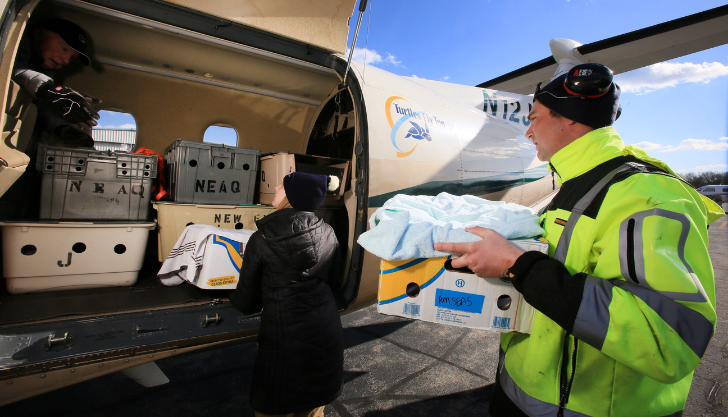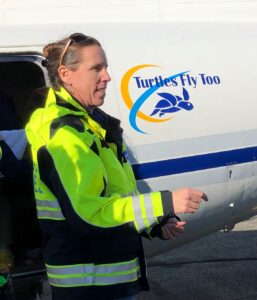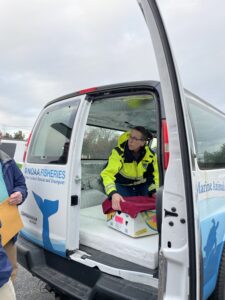Sea turtle rescue season concludes for Shoreline Aviation

Shoreline Aviation has been involved in addressing local aspects of climate warming for 10 years. Here’s what’s been going on.
According to the University of New England, in Maine, the Gulf of Maine is warming faster than 99% of the world’s oceans. From 1982 to 2012 the Gulf of Maine was warming at a rate of about 0.03 degrees Celsius per year, which was a little higher than the rest of the world’s oceans but not significantly higher, an article on the university’s website says. But since 2004 the Gulf has been warming at four or five times that rate.
The Gulf of Maine is 36,000 square miles of relatively enclosed ocean stretching from Cape Cod to Nova Scotia, the UNE piece notes. Here on the Cape Cod end we see an immediate impact of this warming trend, with sea turtles roaming farther and farther north in search of food, which they find plentiful in the warming and relatively shallow Gulf. But, as we’ve reported, these creatures in many cases find themselves stuck here when they try to head back south in the fall. How? They tend to follow the coastline, which often gets them caught in Cape Cod Bay by the long curve of the Cape. They become “cold stunned” by the increasingly cold water and can no longer move on their own, washing onto the beachy shore.
“In 2014 we had a huge stranding season, 1,200 turtles,” said Kate Sampson. Sampson has been a Sea Turtle Stranding and Disentanglement Coordinator with NOAA Fisheries since 2010. Sea turtles are protected under the Endangered Species Act, and her and others’ missions are to reduce mortality.
“There are lots of ongoing efforts at same time,” she said. “We have to make sure they have a good nesting habitat. We also have to protect them while foraging, from fishing gear, marine debris, and vessel strikes. We have people trying to reduce those threats.”

NOAA Sea Turtle Stranding and Disentanglement Coordinator Kate Sampson helps direct a sea turtle loading onto a plane. Photo courtesy of Kate Sampson
The number of strandings since 2014 usually exceeds 750. The recent stranding season had 824, and the later in the season they’re stranded, the sicker they become. Most were the small Kemp’s ridley turtles (685), along with 80 loggerheads and 59 green turtles. Of the 824, 618 were alive. So, what to do with 618 stranded and sick sea turtles? Sampson and associates strive to get them rehabilitated, but that can take months. And that’s where Shoreline Aviation and Marshfield Airport come in.
Stranded sea turtles are gathered along the Cape by volunteers of Wellfleet Bay Wildlife Sanctuary. Most of the turtles are turned over to rehabilitators with the New England Aquarium, at its turtle hospital in Quincy. Overflow Kemp’s ridleys go to the National Marine Life Center in Buzzard’s Bay. The Aquarium fills up as the stranding season progresses and needs to send turtles to other rehab facilities to make room for new arrivals.
Enter Turtles Fly Too, the nonprofit organization started by Leslie Weinstein to help arrange transport of endangered species by the general aviation industry. Sampson serves on its advisory board as NOAA representative.
“We reached out to Marshfield in 2015,” she said. “The airport is perfectly situated for our pilots transporting turtles. And it’s a nice, easy drive for the aquarium. Shoreline dove right in and wanted to engage. Everyone at Shoreline was glad to be part of it and are super helpful.”

NOAA Sea Turtle Stranding and Disentanglement Coordinator Kate Sampson unloads a van full of rehabilitating sea turtles. Photo courtesy of Kate Sampson
That was Sampson’s message to Shoreline staffers at the end of the rehab flight season.
“Hello Shoreline crew,” she wrote. “Thank you so much for a wonderful cold-stunned sea turtle season. We really appreciate your help. Your team is always willing to dive in and help with whatever is needed – loading turtles, fueling quickly, moving planes into the hangar, lending the crew car. You’re generous with your time, always friendly, and just generally a joy to work with. There is a reason why Marshfield Airport is our favorite airport for sea turtle transports!”
Sampson told Shoreliners that 421 turtles were transported this season to long-term rehab out of state – 72 by ground and 349 via flight, coordinated with Turtles Fly Too. Rehabilitating turtles went to 22 receiving facilities in 11 states, and 10 turtles were transported to Florida for release.
Of 15 Massachusetts flights, nine went from Marshfield, the others mostly from Norwood Memorial Airport. Shoreline Aviation staffers help load turtles onto volunteer planes, and Shoreline, which manages the airport, offers volunteer pilots ample fuel discounts and eliminates tie-down fees, as well as freeing up warm hangar space for loading on cold days.

Produce boxes make for excellent turtle packing for flights to rehab facilities. Photo courtesy of Kate Sampson
One special day in December, TV naturalist and Marshfield resident Jeff Corwin arrived at GHG to film part of an episode of his new show for CBS, “Extraordinary World.”
“We’re filming this amazing episode in my back yard,” he said then. “It’s this incredible odyssey about these sea turtles that are rescued by the Sea Turtle Hospital with the New England Aquarium, and they themselves go on this incredible journey with this tapestry of connected conservationists all working together to save the sea turtles. To see my town be a part of this, and this beautiful little gem of an airport, I think it’s really cool.”
“Unfortunately, these turtles will need weeks if not mostly months in order to get fully back to health and be released back into the wild,” Sampson added that day. “And we just don’t have the space in Massachusetts to care for all of those turtles.”
And so rescued sea turtles move on to new care and new homes, mainly from Marshfield Airport.
“This cold-stun response effort is a wonderful example of collaboration,” Sampson said. “Wellfleet Bay Wildlife Sanctuary does beach response, and they are amazing. The two rehab facilities are also amazing, with lots of volunteers. And we get to work with great people like Shoreline and Turtles Fly Too. We all have same goal.”
Cover photo: Marshfield Airport Assistant Manager Ben Garman carries a box of rehabilitating turtles to load onto a plane. Photo courtesy of Lauren Owens Lambert
Back to News